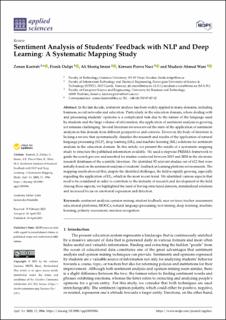| dc.description.abstract | In the last decade, sentiment analysis has been widely applied in many domains, including business, social networks and education. Particularly in the education domain, where dealing with and processing students’ opinions is a complicated task due to the nature of the language used by students and the large volume of information, the application of sentiment analysis is growing yet remains challenging. Several literature reviews reveal the state of the application of sentiment analysis in this domain from different perspectives and contexts. However, the body of literature is lacking a review that systematically classifies the research and results of the application of natural language processing (NLP), deep learning (DL), and machine learning (ML) solutions for sentiment analysis in the education domain. In this article, we present the results of a systematic mapping study to structure the published information available. We used a stepwise PRISMA framework to guide the search process and searched for studies conducted between 2015 and 2020 in the electronic research databases of the scientific literature. We identified 92 relevant studies out of 612 that were initially found on the sentiment analysis of students’ feedback in learning platform environments. The mapping results showed that, despite the identified challenges, the field is rapidly growing, especially regarding the application of DL, which is the most recent trend. We identified various aspects that need to be considered in order to contribute to the maturity of research and development in the field. Among these aspects, we highlighted the need of having structured datasets, standardized solutions and increased focus on emotional expression and detection. | en_US |

